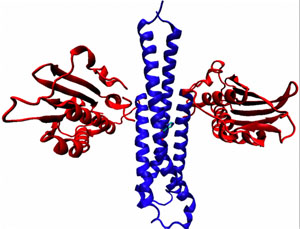
Kate Rozen-Gagnon
Barnard College
Keating Lab
Mentor: Orr Ashenberg
Summer 2009
Exploring Histidine Kinase Dimerization Specificity
Protein-protein interaction specificity is an essential characteristic in any biological signaling pathway. However, the basis of specificity at a sequence level is not fully understood for most protein families. Two-component signal transduction systems (TCSTs) are common in prokaryotes, consist of conserved components, and regulate diverse adaptive responses ranging from chemotaxis to virulence pathways. In a canonical TCST, a histidine kinase (HK), typically a transmembrane receptor existing as a homodimer, receives an external stimulus and autophosphorylates a conserved histidine residue. The HK interacts with its cognate response regulator (RR), transferring the phosphoryl group to a conserved aspartic acid residue of the RR. This activated RR undergoes a conformational change and elicits an output response, either directly or through downstream interaction partners. TCSTs pose several interesting specificity questions, one of which is: given that many different HKs exist in prokaryotic organisms, how do HKs homodimerize in a background with many competing heterodimeric states? We have explored the basis of dimerization specificity in HKs, and hypothesize that HKs specifically homodimerize and that this specificity is encoded at the sequence level. We researched this question in the context of two similar E. coli HKs, EnvZ and RstB. We determined that these HKs do specifically homodimerize and worked toward identifying sequence-level determinants of specificity. Exploring HK homodimerization specificity in the context of TCSTs is of inherent interest for a fundamental understanding of interaction specificity in signaling, and could potentially lead to development of novel antibiotics.
